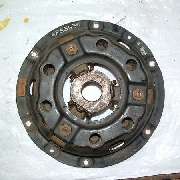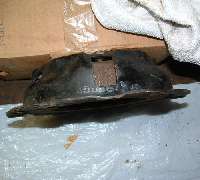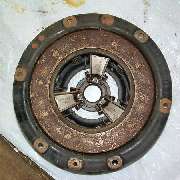The MGA With An Attitude
HYDRAULIC CLUTCH, How It Works - CT-100
On 2/19/2010, Jeff Sutcliffe wrote:
>"I have been trying to figure out how the slave cylinder works. I know what it does and how it does it I just canít figure out exactly how it does it".
Start with the Workshop Manual, Section E. -- Read the first full page of text (E.3) that describes the operation. Also see Fig. E.1. on page E.3

Disassembled parts of the clutch slave cylinder
All hydraulic cylinders in the MGA (other then disc brake calipers) have internal parts similar to those shown above. There will be a light force compression spring, a plastic "filler", a rubber seal cup, and a steel piston. The piston is long enough to be guided straight in the cylinder bore. The piston and seal cup have mating flat faces. The "filler" is a plastic button with beveled edges fitting inside of the rubber cup. This serves to hold the cup flat in contact with the piston. It also presses on the inside of the rubber lip of the cup to keep the lip in contact with the cylinder wall during times of little or no hydraulic pressure. Hydraulic fluid under high pressure pushes against the rubber cup to push the piston forward with great force. When hydraulic pressure is released, external mechanical load will push the piston back into the cylinder bore.
In final assembly the slave piston is pushed well back into the bore and held there by strong force of the clutch pressure plate pushing back against the release bearing, release arm, and slave pushrod. Once fully returned the pressure plate hits mechanical limit at rest, and the only remaining force on the slave cylinder piston is from the light spring inside. Step on the clutch pedal operates the master cylinder to push fluid into the slave cylinder, thereby pushing the slave piston forward to activate the release arm, release bearing and pressure plate (declutching). Releasing the pedal allows fluid to return to the master cylinder as spring force from the pressure plate pushes all mechanical parts back to rest position.
One of the key features here is that the light spring inside the slave cylinder will keep the train of working parts in intimate contact. There will be no clearance or backlash between the seal cup, piston, pushrod, release arm, release bearing, and the input thrust plate on the clutch cover. This mechanism is therefore self-adjusting to compensate for clutch wear and gradual change of position of the operating parts, The graphite faced release bearing will run with gentle intimate contact with the release thrust plate. Graphite against a smooth steel surface is self-lubricating, so it will last a long time before it wears out (perhaps 80,000 miles or more).
If you suspect the clutch is not working properly, you should first check hydraulic operation. Get under the car where you can see the slave cylinder pushrod and clutch release arm. Have a helper step on the clutch pedal. Full stroke of the pedal should produce about 5/8-inch travel at the slave pushrod. If it doesn't give at least 1/2 inch of travel, you have a hydraulic problem that needs to be fixed before you worry about any of the clutch parts inside the bellhousing.



The clutch pressure plate has very strong springs inside, provides a very strong squeeze against the friction disc, and requires considerable force to affect clutch release. From the Twin Cam Engineering data book, six springs on the pressure plate have 200 pounds preload each for a total of 1200 pounds squeeze on the pressure plate. Levers inside the clutch cover assembly have a mechanical ratio of about 3:1, so it requires about 400 pounds of force at the release bearing. The release arm has about 1.5:1 lever ratio, hydraulic slave cylinder to master cylinder has about 2.25:1 mechanical advantage (due to different bore sizes), and the foot pedal has about 3.5:1 lever ratio. Multiply these last three items to get close to the published number of 11.7:1 overall mechanical ratio between pedal and release bearing, 400/11.7 = 34.2, so pedal force requirement would be about 34 pounds under your foot. If I missed a guess and pressure plate internal levers might be 4:1 rather than 3:1, the pedal force might be closer to 25 pounds.
For the standard car clutch (pushrod engines) the mechanical ratio between pedal and release bearing is specified as 9.0:1. This difference must be due to different bore sizes in master and slave cylinders. This would make the standard clutch pedal force 30% higher, but springs in the standard pressure plate may also be somewhat softer, so standard car pedal force might be about the same as for the Twin Cam. 9:1 ratio between pedal and release bearing multiplied by 3:1 ratio for levers inside the clutch cover gives 27:1 over all ratio. So 5 inches pedal travel would withdraw the pressure plate by only 3/16 inch (5/27=.185). Some of this is in rather round numbers (estimates), so actual results could be slightly different. But overall this give a fair perspective on how your left foot can easily apply up to 1200 pounds of force to withdraw the clutch pressure plate.
When all mechanism is back to rest position hydraulic pressure drops to zero and all motion stops. The slave piston is held in the outward directoon with a small internal spring force (you can easily compress this spring between two fingers). This maintains a very small preload on the pushrod, release arm and release bearing. This is just enough force to keep the release bearing in constant contact with the thrust plate on the clutch cover, but not so much force as to cause excessive wear on the carbon release bearing.
When you think of stomping down with 70# force (or more) on the brake pedal for a quick stop, you should realize the hydraulic pressure there may be over 400 psi before the wheels lock up and skid on the pavement.
|



